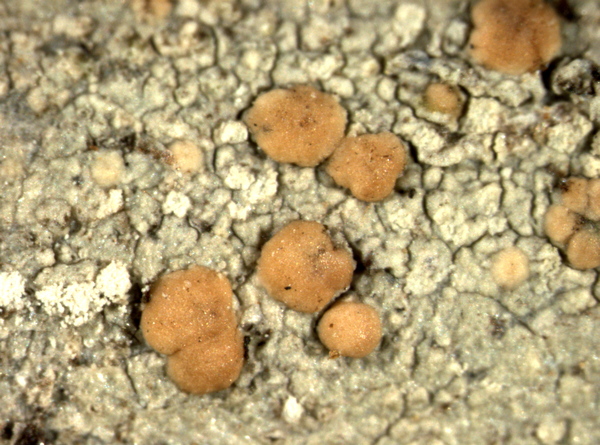Biatora flavopunctata (Tønsberg) Hinter. & Printzen
in Hinteregger, Bibl. Lichenol., 55: 86, 1994. Basionym: Lecanora flavopunctata Tønsberg - Sommerfeltia, 14: 162, 1992.
Synonyms: Myrionora flavopunctata (Tønsberg) S.Y. Kondr.
Distribution: N - Frl (Hinteregger 1994, Printzen 1995, in Austrian terr., near the border), Piem (TSB 33253), Lig.
Description: Thallus crustose, endo- to episubstratic, whitish to greenish grey, greyish green, pale yellow or yellowish grey, forming up to 1.5(-2) cm wide patches, continuous to usually areolate, sorediate, sometimes delimited by a poorly evident, whitish prothallus, the areoles sparse or contiguous, rounded to elongate, flat to convex, up to 0.2(-0.4) mm wide, the continuous parts weakly tuberculate, rimose. Soralia central or marginal on areoles or tubercles, pale yellow to greenish yellow, at first well-delimited and punctiform, (0.1-)0.2-0.4(-0.5) mm across, later more or less confluent, the soredia farinose, 10-20(-25) μm in diam., with a distinct wall, very rarely gathered into 30-55 µm qwide consoredia. Apothecia rather rare, biatorine, adnate, 0.2-0.4(-0.55) mm across, pale brown to flesh-coloured, sometimes with a yellow tinge, slightly convex, without a distinct thalline margin. Proper exciple colourless or brownish, of conglutinated, radiating hyphae, without crystals or with a few crystals in outer part; epithecium straw-coloured to colourless, with a minutely granular epipsamma dissolving in K; hymenium colourless, 30-45 μm high, with large crystals not dissolving in K, I-; paraphyses coherent, simple to sparingly branched, 1-1.5 μm thick at mid-level, the apical cells hardly swollen, up to 2.5 μm wide; hypothecium colourless to pale yellow, 40-70 μm high, K/I+ blue. Asci 8-spored, clavate, Biatora-type, 22-31 x 7-8.5 µm. Ascospores 1-celled to rarely 1-septate, hyaline, mostly narrowly ellipsoid, sometimes slightly curved, 7.5-11(-13.5) x 2.5-4(-5) μm. Pycnidia very rare, inconspicuous, immersed, 30-55 µm across. Conidia bacilliform, 5-7.5 x 0.7-1 µm. Photobiont chlorococcoid, the cells 9-12(-18) μm wide. Spot tests: thallus and soralia K+ yellow, C+ yellowish, P-. Chemistry: atranorin, usnic acid, isousnic acid, variable amounts of stictic acid, traces of cryptostictic acid, flavopunctata-unknown (traces), possible traces of other unidentified terpenoids.Note: a probably boreal-montane species found on twigs of subalpine shrubs, especially Rhododendron ferrugineum; certainly much more widespread in the Alps.
Growth form: Crustose
Substrata: bark
Photobiont: green algae other than Trentepohlia
Reproductive strategy: mainly asexual, by soredia, or soredia-like structures (e.g. blastidia)
Commonnes-rarity: (info)
Alpine belt: absent
Subalpine belt: rather common
Oromediterranean belt: absent
Montane belt: rare
Submediterranean belt: absent
Padanian area: absent
Humid submediterranean belt: absent
Humid mediterranean belt: absent
Dry mediterranean belt: absent

Predictive model
Herbarium samples
Growth form: Crustose
Substrata: bark
Photobiont: green algae other than Trentepohlia
Reproductive strategy: mainly asexual, by soredia, or soredia-like structures (e.g. blastidia)
Commonnes-rarity: (info)
Alpine belt: absent
Subalpine belt: rather common
Oromediterranean belt: absent
Montane belt: rare
Submediterranean belt: absent
Padanian area: absent
Humid submediterranean belt: absent
Humid mediterranean belt: absent
Dry mediterranean belt: absent

Predictive model
| Herbarium samples |
 INDEX FUNGORUM
INDEX FUNGORUM
 GBIF
GBIF
 DOLICHENS
DOLICHENS




